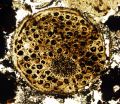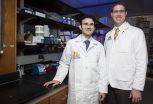(Press-News.org) Experts at LSTM have used a novel modelling approach to project the effects of new diagnostic methods and algorithms for the diagnosis of tuberculosis (TB) recently endorsed by the World Health Organization (WHO), looking at the patient, health system and population perspective in Tanzania.
In a paper published in the journal The Lancet Global Health, LSTM's Ivor Langley and Professor Bertie Squire worked with colleagues from the Institute of Epidemiology and Preventative Medicine, National Taiwan University; National Tuberculosis and leprosy Programme, Tanzania; Department of Epidemiology, Harvard School of Public Health and Brigham and Women's hospital, Boston, MA., using an integrated model to assess the effects of a number different algorithms in order to assist national TB programmes who now face a decision about which methods to implement. The model was designed to represent the operational and epidemiological context of Tanzania and was used to compare the effects and cost-effectiveness of different diagnostic options.
At its heart, the study projected, over a 10 year time frame, three parameters which are critical in health policy decision-making: cost per additional disability-adjusted life-years (DALYs) averted, total DALYs averted, and total health budget. The modelling permitted projection of all three of these parameters for a number of different diagnostic algorithms. The team identified three algorithms as cost-effective in Tanzania, where in 2011 the incidence of TB was 169 per 100,000 with 38% of patients co-infected with HIV.
The algorithm with the greatest cost-effectiveness deployed Xpert MTB/RIF for all presumed TB cases. This is a cartridge based automated diagnostic test that can identify Mycobacterium tuberculosis (MTB) with improved accuracy as well as detect resistance to rifampicin (RIF). Although this algorithm was also below Tanzania's willingness to pay threshold of USD 599 (GDP per head) per DALY, it would cost USD 36 million to implement. This would require Tanzania to mobilise a 25% increase in its total budget for TB control. The next most cost effective algorithm deployed same-day LED fluorescence microscopy for all presumed TB cases. Although the population level effect was less than Xpert MTB/RIF, the additional cost to the health system was only USD 5.7 million; arguably a more affordable option.
Professor Bertie Squire, Senior Author said: "A key feature of our modelling approach is that it takes into account the knock-on effects of introducing a new diagnostic test on the whole diagnostic process in a given context. This is a more useful way of assessing the potential impact of new diagnostics over conventional assessments such as those focussing largely on test accuracy. Our results provide a wish list for policy makers when deciding to deploy new diagnostics in a country, and the model not only predicts that a full roll-out of Xpert is a cost-effective option with the potential to substantially reduce the national burden of TB, but estimates the substantial level of funding that will need to be mobilised to translate this into clinical practice. Although we focussed only on Tanzania in the present analysis, our key findings on the rank of alternative diagnostic options should be generalizable to countries of similar operational and epidemiological situations."
INFORMATION:
This research was supported through TREAT TB – a USAID-funded research initiative led by the International Union Against Tuberculosis and Lung Disease (The Union).
For further information, please contact:
Mrs Clare Bebb
Senior Media Officer
Liverpool School of Tropical Medicine
Office: +44 (0)151 705 3135
Mobile: +44 (0)7889535222
Email: c.bebb@liv.ac.uk
Liverpool School of Tropical Medicine (LSTM) has been engaged in the fight against infectious, debilitating and disabling diseases since 1898 and continues that tradition today with a research portfolio in excess of well over £200 million and a teaching programme attracting students from over 65 countries.
For further information, please visit: http://www.lstmliverpool.ac.uk
Experts at LSTM use modelling approach to assess the effectiveness TB diagnostics
Experts at LSTM have used a novel modelling approach to project the effects of new diagnostic methods and algorithms for the diagnosis of TB recently endorsed by the WHO
2014-09-25
ELSE PRESS RELEASES FROM THIS DATE:
Simple blood test could be used as tool for early cancer diagnosis
2014-09-25
High levels of calcium in blood, a condition known as hypercalcaemia, can be used by GPs as an early indication of certain types of cancer, according to a study by researchers from the universities of Bristol and Exeter.
Hypercalcaemia is the most common metabolic disorder associated with cancer, occurring in 10 to 20 per cent of people with cancer. While its connection to cancer is well known, this study has, for the first time, shown that often it can predate the diagnosis of cancer in primary care.
A simple blood test could identify those with hypercalcaemia, prompting ...
Perfectionism is a bigger than perceived risk factor in suicide: York U psychology expert
2014-09-25
TORONTO, September 25, 2014 – Perfectionism is a bigger risk factor in suicide than we may think, says York University Psychology Professor Gordon Flett, calling for closer attention to its potential destructiveness, adding that clinical guidelines should include perfectionism as a separate factor for suicide risk assessment and intervention.
"There is an urgent need for looking at perfectionism with a person-centred approach as an individual and societal risk factor, when formulating clinical guidelines for suicide risk assessment and intervention, as well as public ...
New findings on how brain handles tactile sensations
2014-09-25
The traditional understanding in neuroscience is that tactile sensations from the skin are only assembled to form a complete experience in the cerebral cortex, the most advanced part of the brain. However, this is challenged by new research findings from Lund University in Sweden that suggest both that other levels in the brain play a greater role than previously thought, and that a larger proportion of the brain's different structures are involved in the perception of touch.
"It was believed that a tactile sensation, such as touching a simple object, only activated a ...
Massive weight loss increases risk of complications in body-shaping surgery
2014-09-25
DALLAS – Sept. 25, 2014 – Patients who lost more than 100 pounds and those who shed weight through bariatric surgery had the highest risk of complications from later surgical procedures to reshape their leaner bodies, a new study from UT Southwestern Medical Center shows.
The study, published in the Aesthetic Surgery Journal, compared surgical complication outcomes for 450 patients who underwent body contouring, a type of surgery to remove excess sagging fat and skin to improve body shape.
"This is one of the first large-scale studies comparing outcomes in patients ...
Natural selection causes early migration and shorter parental care for shorebirds
2014-09-25
All bird migrations are fraught with danger – from the risk of not finding enough food, to facing stormy weather, and most importantly – trying not to be eaten along the way. Raptors such as peregrine falcons (see picture) are the main predators of migratory birds, and huge flocks of congregating shorebirds can be easy pickings. In a paper, just published in Animal Migration, an open access journal by De Gruyter Open, Dr. Sarah Jamieson and her colleagues provide new evidence that shorebird species can adopt substantially different ways of dealing with this predation pressure.
It ...
Spot on against autoimmune diseases and chronic inflammations
2014-09-25
This news release is available in German.
The immune system functions as the body's police force, protecting it from intruders like bacteria and viruses. However, in order to ascertain what is happening in the cell it requires information on the foreign invaders. This task is assumed by so-called immunoproteasomes. These are cylindrical protein complexes that break down the protein structures of the intruders into fragments that can be used by the defense system.
"In autoimmune disorders like rheumatism, type 1 diabetes or multiple sclerosis as well as severe ...
Discovery may lead to better treatments for autoimmune diseases, bone loss
2014-09-25
Scientists have developed an approach to creating treatments for osteoporosis and autoimmune diseases that may avoid the risk of infection and cancer posed by some current medications.
Researchers at Washington University School of Medicine in St. Louis redesigned a molecule that controls immune cell activity, changing the molecule's target and altering the effects of the signal it sends.
Current treatments for bone loss and autoimmune disorders block these molecules and their signals indiscriminately, which over time increases the risk of infections and cancer. The ...
Fossil of multicellular life moves evolutionary needle back 60 million years
2014-09-25
A Virginia Tech geobiologist with collaborators from the Chinese Academy of Sciences have found evidence in the fossil record that complex multicellularity appeared in living things about 600 million years ago – nearly 60 million years before skeletal animals appeared during a huge growth spurt of new life on Earth known as the Cambrian Explosion.
The discovery published online Wednesday in the journal Nature contradicts several longstanding interpretations of multicellular fossils from at least 600 million years ago.
"This opens up a new door for us to shine some light ...
NCI/FDA lung cancer workshop leads to the innovatively designed clinical trials
2014-09-25
DENVER – The recent launch of two clinical trials offer innovative study designs for patients with lung cancer. These clinical trials are the direct result of a National Cancer Institute (NCI) sponsored workshop chaired by Drs. Fred R. Hirsch, Shakun Malik and Claudio Dansky- Ullman, that brought together the NCI Thoracic Malignancies Steering Committee, the US Food and Drug Administration (FDA), academicians, clinicians as well as industry and government stakeholders to discuss issues and challenges related to clinical trial design and biomarkers for lung cancer targeted-therapies.
The ...
Treatment studied to help patients 'burned to the bone'
2014-09-25
An anti-inflammatory treatment, studied in the labs of regenerative medicine specialists and trauma surgeons, may prevent what's become one of the war-defining injuries for today's troops.
Those burned by high-velocity explosive devices are at-risk for heterotopic ossification (HO), in which bone develops in places it shouldn't be, outside the skeleton, in joints, muscles and tendons. The painful condition can make it difficult to move and function and commonly affects patients who suffer burns, automobile accidents, orthopedic surgery and blast injuries and other combat ...
LAST 30 PRESS RELEASES:
Boosting the cell’s own cleanup
Movement matters: Light activity led to better survival in diabetes, heart, kidney disease
Method developed to identify best treatment combinations for glioblastoma based on unique cellular targets
Self-guided behavioral app helps children with epilepsy sleep earlier
Higher consumption of food preservatives is associated with an increased risk of type 2 diabetes
NTU Singapore-led team captures first-ever ‘twitch’ of the eye’s night-vision cells as they detect light, paving the way for earlier detection of blindness-causing diseases
Global aviation emissions could be halved through maximising efficiency gains, new study shows
Fewer layovers, better-connected airports, more firm growth
Exposure to natural light improves metabolic health
As we age, immune cells protect the spinal cord
New expert guidance urges caution before surgery for patients with treatment-resistant constipation
Solar hydrogen can now be produced efficiently without the scarce metal platinum
Sleeping in on weekends may help boost teens’ mental health
Study: Teens use cellphones for an hour a day at school
After more than two years of war, Palestinian children are hungry, denied education and “like the living dead”
The untold story of life with Prader-Willi syndrome - according to the siblings who live it
How the parasite that ‘gave up sex’ found more hosts – and why its victory won’t last
When is it time to jump? The boiling frog problem of AI use in physics education
Twitter data reveals partisan divide in understanding why pollen season's getting worse
AI is quick but risky for updating old software
Revolutionizing biosecurity: new multi-omics framework to transform invasive species management
From ancient herb to modern medicine: new review unveils the multi-targeted healing potential of Borago officinalis
Building a global scientific community: Biological Diversity Journal announces dual recruitment of Editorial Board and Youth Editorial Board members
Microbes that break down antibiotics help protect ecosystems under drug pollution
Smart biochar that remembers pollutants offers a new way to clean water and recycle biomass
Rice genes matter more than domestication in shaping plant microbiomes
Ticking time bomb: Some farmers report as many as 70 tick encounters over a 6-month period
Turning garden and crop waste into plastics
Scientists discover ‘platypus galaxies’ in the early universe
Seeing thyroid cancer in a new light: when AI meets label-free imaging in the operating room
[Press-News.org] Experts at LSTM use modelling approach to assess the effectiveness TB diagnosticsExperts at LSTM have used a novel modelling approach to project the effects of new diagnostic methods and algorithms for the diagnosis of TB recently endorsed by the WHO





